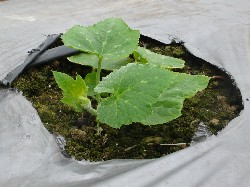

#Pumpkin plant seedlings Patch
Keep in mind that hybrid pumpkins won’t grow true to seed, whereas heirloom and open-pollinated varieties will be identical to their parent plants – unless they were cross-pollinated by a different variety.Īnother reason why we made those mounds when we were setting up our patch for growing was to increase the temperature of the soil for our seeds. Remember to label it with the variety and the date. Place them into an envelope and hold onto them until the growing season. I’m a fan of placing my seeds randomly in desk drawers and glassware cabinets to dry – it’s fun to hear my wife’s reaction when she finds them!Īfter a week or so, the seeds should be plenty dry. Since you’re going to prepare your patch so far in advance, this is a great activity to keep you busy in the meantime! If you’re collecting your own seeds from the guts of your jack-o’-lantern, simply spread the fresh seeds in a single layer on a paper towel and set it someplace dry and cool. I promise, your Future Gardening Self will thank your Past Gardening Self for doing this work ahead of time. The purpose of mounding the soil is to increase drainage, and to provide a base of rich organic matter for your plants.īy prepping this mound six months to a year before you plant, you’ll be ready to plop those seeds in and get right to growing when planting season arrives. Place the soil back into the hole and add more until you’ve got a mound formed, about the size of a baseball base. At the bottom of this hole, place a layer of aged manure or compost about two to four inches should do the trick. Start with digging a hole about 12 inches deep by 12 inches wide. Sound like a problem? Don’t fret! It’s a pretty simple process to achieve this. Pumpkins want good drainage, and warm, rich soil.
#Pumpkin plant seedlings free
Those long runners of vines can be cut and removed to free up walkways. I’ve seen people grow pumpkins in their front perennial beds to have built-in autumn decor ready for Halloween. Start with finding a location where you can let your vines grow with abandon – and keep in mind that you can get creative with it. Smaller varieties will take up less space. You should plan to space the mounds about four to eight feet apart, and on average you’ll be able to fit two or three plants per mound, depending on the cultivar that you select. You’ll want your growing area to be in a location that gets lots of sun, though they can tolerate some light shade. A good, solid year of preparation is just what the soil needs to ensure the productivity of your patch. In fact, the best way to guarantee success is to start prepping your pumpkin patch right away. If you’re not sure about the composition of your soil, you can do a soil test. Pumpkins typically are at their best in USDA Hardiness Zones 3-9, and they prefer soil that is slightly acidic to neutral in its pH. Let’s get to it! Planning for Your Pumpkin Patch


 0 kommentar(er)
0 kommentar(er)
